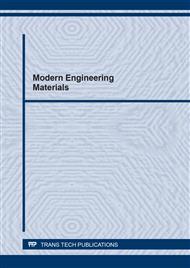[1]
T. Oke, The heat island of the urban boundary layer: characteristics, causes and effects, Wind climate in cities, (1995), 81-107.
DOI: 10.1007/978-94-017-3686-2_5
Google Scholar
[2]
S. Lehman, Urban heat island towards urban climate, Earth and Environmental Science, 118 (2018), 1-6.
Google Scholar
[3]
S. Lehman, Low carbon districts: Mitigating the with green roof infrastructure, City, Culture and Society, 5 (2014), 1-8.
Google Scholar
[4]
M. Nuruzzaman, Urban heat island: Causes, effects and mitigation measures-A review, International journal of environmental monitoring and analysis, 3 (2015), 67-73.
DOI: 10.11648/j.ijema.20150302.15
Google Scholar
[5]
P. Bevilacqua, D. Mazzeo, N. Arcuri, Thermal inertia assessment of an experimental extensive green roof in summer conditions, Building and Environment, 131 (2018), 264-276.
DOI: 10.1016/j.buildenv.2017.11.033
Google Scholar
[6]
R. Arabi, M. Shahidan M., M. Afar, M. Rakhshandehroo, Mitigating urban heat island through green roofs, Current World Environment, 10 (2015), 918-927.
DOI: 10.12944/cwe.10.special-issue1.111
Google Scholar
[7]
E. Jamei, H. Wah, M. Seyedmahmoudian, A. Stojcevski, Review on the cooling potential of green roofs in different climates, Science the Total Environment, 791 (2021), 1-15.
DOI: 10.1016/j.scitotenv.2021.148407
Google Scholar
[8]
P. Bevilcqua, R. Bruno, N. Arcuri, Green roofs in a Mediterranean climate: Energy performances based on in-situ experimental data, Renewable Energy, 152 (2020), 1414-1430.
DOI: 10.1016/j.renene.2020.01.085
Google Scholar
[9]
S. Cascone, J. Coma, A. Gagliano, G. Pérez, The evapotranspiration process in green foofs: A review, Building and Environment, 14 (2019), 337-335.
DOI: 10.1016/j.buildenv.2018.10.024
Google Scholar
[10]
M. Köhler, M. Schmidt, M. Laar, Green roofs as a contribution to reduce urban heat islands, Rio 3-World climate & Energy Event, 1 (2003), 493-498.
Google Scholar
[11]
D. Kolokotsa, M. Santamouris, S. Zerefos, Green and cool roofs urban heat island mitigation potential in european climates for office buildings under free float conditions, Solar energy, 95 (2013), 118-130.
DOI: 10.1016/j.solener.2013.06.001
Google Scholar
[12]
E. Alexandri, P. Jones, The thermal effects of green roofs and green façades on an urban canyon, Conference on passive and low energy architecture, The Netherlands, (2004).
Google Scholar
[13]
M. Monteiro, T. Blanusa, A. Verhoef, M. Richardson, P. Hadley, R. Cameron, Functional green roofs: Importance of plant choice in maximizing summertime environmental cooling and substrate insulation, Energy and Buliding, 141 (2017), 56-68.
DOI: 10.1016/j.enbuild.2017.02.011
Google Scholar
[14]
J. Lundholm, Green roof plant species diversity ecosystem multifuncionality, Journal of Applied Ecology, 52 (2015), 726-734.
DOI: 10.1111/1365-2664.12425
Google Scholar
[15]
A. Naranjo, A. Colonia, J. Mesa, H. Maury, A. Maury-Ramírez, State of the art green roofs: Technical performance and certifications for sustainable construction, Advances Coatings for Buildings, 10 (2020), 1-14.
DOI: 10.3390/coatings10010069
Google Scholar
[16]
T. Wheeler, J. Osborne, Sydney City Council Green Roof Resource Manual, Sydney, (2010).
Google Scholar
[17]
J. MacIvor, J. Lundholm, Performance evaluation of native plants to extensive green roof conditions in a maritime climate, Ecological Engineering, 37 (2011), 407-417.
DOI: 10.1016/j.ecoleng.2010.10.004
Google Scholar
[18]
B. Dvorak, A. Volder, Rooftop temperature reduction from unirrigated modular green roofs in sout central Texas, Urban Forestry & Urban Greening, 12 (2013), 28-35.
DOI: 10.1016/j.ufug.2012.05.004
Google Scholar
[19]
S. Nirmal, V. Tambe, M. Chavan, Chemical composition and antimicrobial activity of essential oil from the leavers of wedelia trilobata, Indian Journal of Natural Product, 21 (2005), 33-35.
Google Scholar
[20]
M. DellaGreca, C. Di Marino, L. Previtera, R. Purcaro, A. Zarrelli, Apteniols A_F, oxyneolignans from the leaves of Aptenia cordifolia, Tetrahedron, 61 (2005), 11924-11929.
DOI: 10.1016/j.tet.2005.09.054
Google Scholar
[21]
Y. Lin, H. Lin, Thermal performance of different planting substrates and irrigation frequencies intensive tropical rooftop greeneries, Building and Environment, 46 (2011), 345-355.
DOI: 10.1016/j.buildenv.2010.07.027
Google Scholar
[22]
Centre for Agriculture and Bioscience International, Sphagneticola trilobata (wedelia), information on https://www.cabi.org/isc/datasheet/56714.
Google Scholar
[23]
South African National Biodiversity Institute, Aptenia cordifolia, information on, http://pza.sanbi.org/aptenia-cordifolia.
Google Scholar



